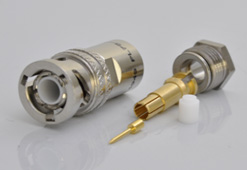Dieser Beitrag ist auch verfügbar auf:
![]() German
German ![]() French
French ![]() Spanish
Spanish
Anyone who has ever assembled a coaxial cable assembly knows the problem: you know your own application and have precise ideas about what properties the desired cable must have. The right cable is usually found quickly, but when it comes to selecting the right connectors, the euphoria is curbed. Because in addition to the numerous different types of plugs, sockets, reverse plugs, panel jacks and much more, there is also the not exactly small number of different manufacturers to consider. So not only do you have to find the right type of connector for your application, but you also have to be aware of the advantages and disadvantages of different manufacturers.
After all, what exactly makes the difference between a BNC connector for 2 euros and one for 5 euros?
Why the price difference?
But let’s start at the beginning: What exactly do we mean by the term RF connectors?
These are components with the task of creating a suitable, low-loss connection for frequency transmission to a corresponding counterpart. They consist of a housing and an interior and are roughly divided into plugs and their counterpart sockets. Plugs, also given the gender “male”, are those connectors whose inner workings have a so-called “inner pin”. Sockets “female” are the corresponding counterpart with a hollow pin.
Frequency and temperature
The frequency at which the coaxial cable is used is important for selecting the right connectors. The connectors must also be oriented to this, because even if the cable is designed for 6 GHz, for example, but the connectors are only designed for 2.5 GHz, they are less suitable for your application. Of course, the same also applies to the environmental conditions of your application. If your assembly is exposed to high temperatures, for example, it is not enough if only the cable can withstand them, because the connectors must be designed for this in the same way. So the following applies here: You must not only place your requirements on the cable, but also on the connectors that are to be assembled on it.
What do mating cycles mean?
Another important point is the durability of your application. Is it a test setup in the course of which the connectors have to be plugged in and unplugged frequently? Or do you make the connection once and the setup always remains the same? This aspect is very important for choosing the right connector, because no one wants a connector that you want to use repeatedly to no longer be functional after a few applications. Often, a higher price here also stands for higher quality. If we look at the inner pin of a higher-priced connector, for example, we notice that it is usually gold-plated. Although this material offers high conductivity, it also drives up the price of the connector. If you want to avoid this price increase, you may tend to reach for an unbranded connector, as this is considerably cheaper. In this case, however, you must reckon with the fact that this cheaper connector offers considerably fewer mating cycles than a high-quality connector. You will look in vain for a genuine gold-plated inner pin, as it is usually only a low-quality alloy that can flake off over time. Once this happens, the plug is no longer functional.
In general, it can be said that there is also a connection between the size and the durability of the connector. Smaller connectors tend to offer fewer mating cycles than larger ones. So if the durability of a connector is important for your application, it is highly recommended that you pay close attention to the manufacturer’s specification, as they often specify a number of mating cycles that their connector is rated for.
Proportionality
But before you come to the fallacy that the most expensive connector is always the best, you should first weigh up again which properties are important to you for your application in order to find a compromise between connector properties and costs. It makes little sense to buy a connector that is designed for a frequency of 18 GHz and is correspondingly expensive if you use it at a maximum of 1 GHz.
Finally, we can recommend a certain manufacturer loyalty. If you use a cable from a certain manufacturer, you tend to be better off if you also buy your connectors from that manufacturer than if you use a product from another brand or an unbranded connector.
We hope that with this article we have been able to offer you a little help in choosing the right connector. Next month, read all about choosing the right coaxial cable for your application.
Coaxial cables:
RG178 | RG196 A/U | RGL196 LowNoise | KAPTON 1.45MM | LN5001 LowNoise | Sucoform 86 | RG174 A/U | RG174 LSNH | RG188 A/U | RG316 /C | RG316 /U | RGL316 LowNoise | RG316D – RD316 | ENVIROFLEX 316D | CLF100 | LMR 100A | LN5002 LowNoise | BEDEA MXR 0.45/1.4L, LowNoise | PE-P086 | Multiflex 86 | Sucoform 86 FEP | Sucoform 86 LSFH | K 02252 D | SS405 | Multiflex 141 | Sucoform 141 | Sucoform 141 FEP | PE-P141 | SS402 | RG58 | RG058 | RG58 ALL | arnoflex 58 LSNH | RG58 PUR | Enviroflex 142 | RG142 | LL142 | RG223 U | Enviroflex 400 | RG400 | H-155 PE | H-155 FRNC | H-155 PVC | WC-55 PE | HyperFlex 5 | CLF195 | CLF200 | CLF240 | LMR 195 | LMR 195 UF | HF 195 ZH | LMR 200 | LMR 240 | LMR 240 UF | HF 240 ZH | Airborne 5 | Aircell 5 | 7806A | S_04212_B | S_04272_B | SPUMA_240-FR-01 | Aircell 7 | arnoflex 7 UF | HIGHFLEXX 7 | SCF14-50J | RG213 /U | RG214 /U | arnoflex 214 LSNH | LMR 400® | LMR 400 UF® | HF 400 LSNH | HyperFlex 10 | Ecoflex 10 | Ecoflex 10 Plus | Aircom Premium® | Ecoflex 15 | Ecoflex 15 plus | LMR 600 | LMR 600 FR |
Coaxial cables 75R / video application:
Coaxial cable 75Ω | RG6 A/U | RG11 A/U | RG59 B/U | RG59 DS | RG59 Flex | arnoflex 59 LSNH | RG175 AF | RG179 B/U | RG179 B/U | RG187 A/U | RG302 /U | 0.41/1.9 AF FRNC | arnoflex 0.4/1.9 | 0,6/2,8 AF | arnoflex 0.6/2.8 | HD PRO 0.6/2.8 AF | 0.6/3.7 PVC | arnoflex 0.8/3.6 | 0.8/3.7 AF | 1.0/4.8 AF | 1.2/4.8 SC-Vector Plus | 1.2/4.8 SC-AQUA MARINEX
